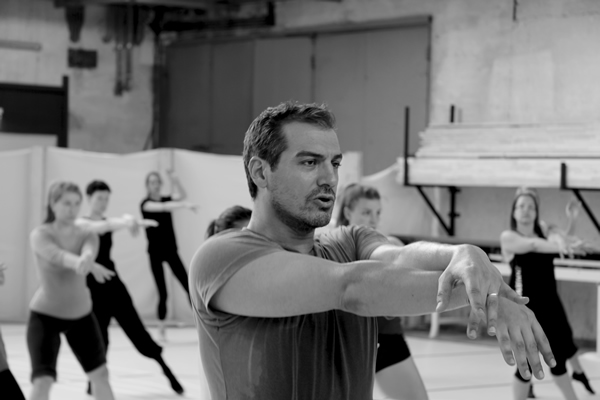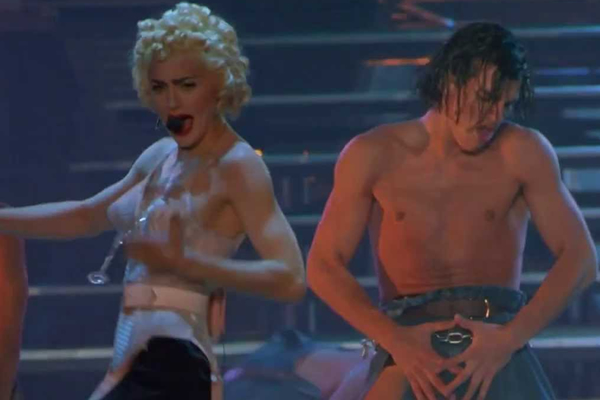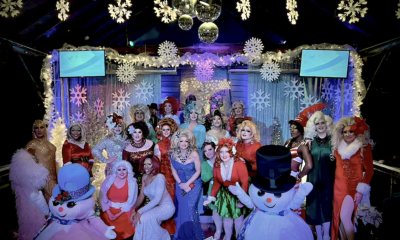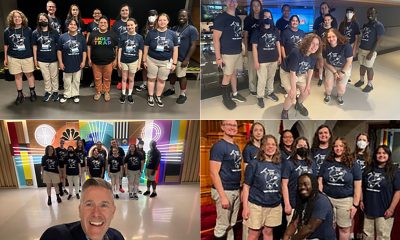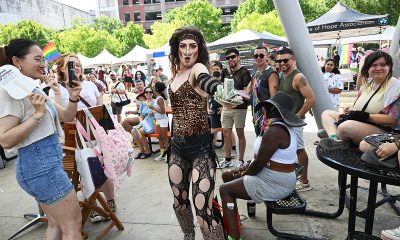a&e features
Former Madonna dancer Slam recalls ‘Blond Ambition Tour,’ ‘Truth or Dare’
Salim Gauwloos revisits landmark film on its 25th anniversary
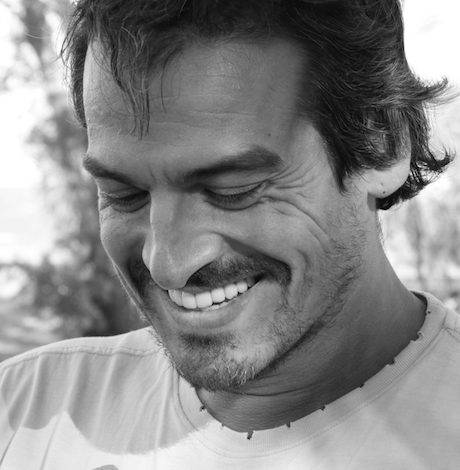
“Truth or Dare”
Monday, Sept. 12
9 p.m.
AFI Silver
$13
8633 Colesville Rd.
Silver Spring, Md.
“Madonna: Truth or Dare,” the landmark 1991 documentary (aka “In Bed With Madonna”) is widely remembered not only as an eye-popping memento of the singer’s legendary “Blond Ambition Tour,” but also as a gay cultural touchstone.
In some ways, it’s the gay equivalent of classic rockumentaries like “Gimme Shelter” or “The Last Waltz” but it’s more than that, too. Not only because it captures Our Lady at the peak of the zeitgeist, but also because its depiction of Madonna’s back-up dancers (of the seven, only Oliver Crumes was straight) being so matter-of-factly out that it felt almost otherworldly to the gay boys who lapped it up in Peoria and everywhere else.
In honor of its anniversary — it screens twice in the coming days at the AFI Silver — we caught up with Salim “Slam” Gauwloos, one of the “Blond Ambition” dancers whose onscreen kiss with the late Gabriel Trupin is one of the film’s most memorable moments. His comments have been slightly edited for length.
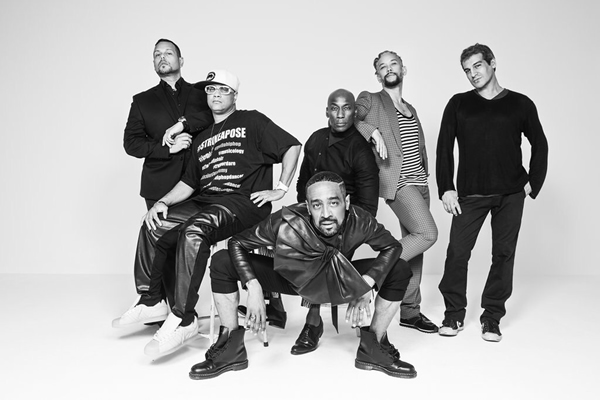
Madonna’s ‘Blond Ambition Tour’ dancers, made famous in the film ‘Truth or Dare,’ reunited for ‘Strike a Pose.’ Clockwise from left are Luis Camacho, Oliver Crumes, Carlton Wilborn, Kevin Stea, Jose Gutierez and Salim Gauwloos. (Photo by Robin De Puy)
WASHINGTON BLADE: Before we get to “Truth or Dare,” tell us a little about “Strike a Pose,” the reunion documentary you’re in with the other “Blond Ambition Tour” dancers. When will we get to see it in Washington?
GAUWLOOS: It’s a great movie, you’ll enjoy it. They’re working on a U.S. theatrical release early next year. Before everybody downloads it. You’ll see it soon. It’s a beautiful movie. They did a great job.
BLADE: But it has already been on the festival circuit, right?
GAUWLOOS: Yes. We mostly go out in twos, only in Berlin and Amsterdam they flew everybody over, but mostly just two of us to wherever. I went to Colombia, to Tel Aviv. It takes a lot of time always, but it’s fun. Almost like being on tour again.
BLADE: How did they pitch you on “Strike a Pose”?
GAUWLOOS: They approached me in 2013. I was doing a job, this big dance festival in Vienna and they contacted me. I said, “OK, I’ll meet with Reijer Zwaan,” one of the directors. He came to meet me in Vienna and we must have talked for about eight hours. It just felt right, I don’t know. I think the directors, Ester Gould and Reijer Zwaan, these directors from Holland, they’re amazing storytellers. I did kind of think, “Do I really want to throw myself out there again to be judged really in some kind of way, I want to be careful about that,” but I had a really good feeling about it.
BLADE: Did you talk to the other dancers before agreeing to it?
GAUWLOOS: No. I think the last one to jump on board was Jose (Gutierez). I felt it really should be all the dancers. Of course Gabriel (Trupin), he passed away a long time ago, but his mother represents him in the movie and that’s really beautiful. It wouldn’t have been the same without all the dancers so in the end, we all agreed and started shooting in 2014.
BLADE: Had you seen the other five any since the “Truth or Dare” premiere or kept in touch with them at all?
GAUWLOOS: No. For example, Carlton (Wilborn), Oliver (Crumes) and Kevin (Stea), I hadn’t seen for probably close to 25 years. Maybe 24 years. And Luis (Camacho) I’d seen a little bit here and there but that was probably like 12 years. Jose (Gutierez) and I both live in New York so I saw him a little bit here and there but with most of them, I’d had literally no contact at all. It was so amazing to see them all again after 25 years.
BLADE: What was different about this project?
GAUWLOOS: We’ve been approached so many times but in the end, it’s just mostly about Madonna but these guys really wanted to know what happened with us during the tour and what was happening with us right now, 25 years later, what we were up to, so that was really nice.
BLADE: You said recently that Reijer Zwaan was almost like your psychiatrist. How so?
GAUWLOOS: You probably know I was diagnosed in 1987 as being HIV-positive and I wanted to be out with that for a long time. It just felt silly to not be. So then along came Reijer and we talked for eight hours and it just all came out you know, crying and it was really the first time I sat with somebody I didn’t really know and told them, “Yes, I’ve been HIV for 29 years,” 27 at the time. I was like, “Oh my God, I feel like I’ve just been to a psychiatrist.” I’ve never been to a real one. Maybe I should (laughs).
BLADE: Madonna made a surprise appearance at a “Truth or Dare” anniversary screening a couple weeks ago in New York. What did it feel like when she walked in the room unannounced?
GAUWLOOS: It was surreal. We were just sitting there and we’re thinking, “OK, why isn’t the movie playing?” and boom, she walks in. It was like the whole room just gasped for air. You couldn’t believe it was real. She just sat down, watched the movie and left. But it was amazing.
BLADE: Had you seen her at all in the last 25 years?
GAUWLOOS: I hadn’t seen her in a long, long, long time. People on social media were like, “Oh my God, did she talk to you guys?” but we were in the front row and she was more in the back. Jose and I should have gone up to her but it wasn’t really the right moment. When she walked in it was just like, “Whoah, I’ve never felt that kind of energy in one room.” It was interesting watching the movie with her. It’s a good film. Very funny.
BLADE: How does it strike you seeing it now?
GAUWLOOS: I watched it a few years ago before we did “Strike a Pose.” When I see it I’m like, “Oh my God, my hair.” Me and my hair, it’s the only thing I can look at. I can’t stop flipping it, you know. It’s like I was so busy with my hair always. I’m just happy to have been part of such a big, iconic moment. If you look at the concert footage, it doesn’t look dated. The whole thing is just amazing. The least annoying thing for me is the kiss, the most important gay kiss in history. That I don’t have a problem watching but some of it I’m like, “Oh my God, no I did not just say that.” It’s like going back in time. It was a good experience.
BLADE: Wasn’t your hair sort of annoying at that length always falling in your face?
GAUWLOOS: Well when you dance, your hair flies around so it has more of an effect. I liked having longer hair and swinging it around.
BLADE: Speaking of hair, why did Madonna change her hair halfway through the tour? That ponytail look was so iconic for her but then she did the curls, which became kind of a trademark look too. It feels odd to me watching “Truth or Dare” because she’s always backstage and it’s supposed to make you feel like she’s walking out into the concert footage but it doesn’t match because she has the different hair.
GAUWLOOS: It was just like one day she had the ponytail and then she just went to the Shirley Temple curls. I don’t think there was any specific reason for it. With the ponytail sometimes it would fly around in your face so I think the curls were easier. Personally I liked the curls more.
BLADE: I’m sure you got wacked in the face with that ponytail a few times.
GAUWLOOS: Yeah and as a girl dancing with a ponytail, it’s like a delayed slap and it must have been difficult for her too.
BLADE: But it wasn’t that her hair was falling out from too much bleaching or pulling up or anything?
GAUWLOOS: No. She had strong hair.
BLADE: Do you feel she’s a bit aloof with you guys or do you think that’s just the way any major star would pretty much be?
GAUWLOOS: I don’t know. After 25 years, you know, it’s a long time. People go on with their life and deal with things in different ways. I mean I just knew sitting there she wasn’t going to run up to us and be like, “Oh my God,” you know? I knew that was not going to happen. It’s not really in her character to be like that. But who am I to judge? You know how you don’t see other people for many years and people react all different ways, so I don’t really judge that.
BLADE: Is it true (“Truth or Dare” director) Alek Keshishian said all the hundreds of hours of outtakes got accidentally deleted?
GAUWLOOS: Not deleted, but nobody knows where it is.
BLADE: I thought it was lame when the Blu-ray release came out a few years ago they didn’t put like 20 minutes or a half-hour of outtakes on it as bonus material. That would have been fun to see.
GAUWLOOS: Supposedly all these people claim not to know where it is. It’s lost.
BLADE: I’m sure it will surface maybe for the 50th anniversary or something.
GAUWLOOS: I know, right? Of course it will. It always does.
BLADE: Was there any dance move or routine that was especially tricky to learn for the tour?
GAUWLOOS: Well I had to learn to vogue, but it wasn’t particularly difficult. The only people who knew what that even was before were Luis, Jose and Madonna, who hired them. Being a classically trained dancer, it wasn’t really a challenge but it was one thing I had to learn. I think it came pretty naturally for everybody. The rest was just hard work. A lot of rehearsals. That’s how we got a really tight show together like that.
BLADE: Is it true you did like two weeks of twice-a-day run throughs before it premiered?
GAUWLOOS: Oh definitely. We were in the studio like 10-12 hours then at the end there were tech rehearsals at night too. It was a crazy, crazy schedule but you know, we were so young, talented and hungry so we didn’t care. We were all in it 100 percent.
BLADE: By the end, were you drenched in sweat and exhausted or were you in such great shape that you weren’t?
GAUWLOOS: People always think the numbers I was featured in like “Express Yourself” or the Dick Tracy part would be the most exhausting but those were the ones you could enjoy more. The most exhausting number to do was “Like a Prayer” because we had this whole big number while she’s changing for the next number. That you were like, “OK, now I can’t breathe.” (laughs)
BLADE: Do you have any mementos from the tour? Any costumes or anything?
GAUWLOOS: I did but I lost all of them, just having moved so many times. When we started shooting “Strike a Pose,” they were like, “Show us some pictures” and I was like, “I don’t have anything.” It’s kind of sad. Only in my head.
BLADE: So you don’t have the rosary Madonna gave you?
GAUWLOOS: No, I definitely don’t have it. I should just buy one and say it’s the one she gave me. (laughs)
BLADE: Some of the choreography was so gay but you were kind of the straight hunk too in some passages. Did that strike you as ironic?
GAUWLOOS: No, it’s like being an actor. Some passages I was acting as a straight dance partner for Madonna so I was acting straight. Not every dancer could do it. But it mostly came natural and from just doing it over and over.
BLADE: Did you bulk up for the tour or were you always kind of built like that?
GAUWLOOS: Starting out in Antwerp, Belgium as a dancer I was really skinny. Then I came to America, I got a little bit bigger. For the tour we were supposed to go to the gym but of course we never went. It was just the cruel rehearsal schedule that kind of got everybody in shape. It’s like 10 hours of dancing, how can you not be in shape from that? That’s how I got bigger and more muscular. I definitely didn’t look like that when we started, definitely not.
BLADE: Did you see “I’m Going to Tell You a Secret,” the “Truth or Dare” sequel?
GAUWLOOS: I saw a little part of it, not the whole thing. I heard the dancers did not get as much of a part. No kissing, in other words. Not X-rated. (laughs)
BLADE: Did you grow up Catholic?
GAUWLOOS: No, not really. My mom would say she was Catholic but we never went to church. It was just kind of like, “Well, we walk by the church.” But definitely not. My father was Muslim. I’m half Moroccan. He was from Morocco but he passed away and was only in my life a couple years and then he disappeared. I’m a little bit of everything but I don’t go to church or practice.
BLADE: So did all the religious imagery in the show resonate with you at all?
GAUWLOOS: No, it was more of a theatrical thing for me with the crosses and the lights. I never felt like, “Oh my God, this is sacrilegious” or anything. I just saw it as a show. I was probably the least knowledgeable about how controversial and taboo it was for the time.
BLADE: The “Vogue” VMA performance with the Marie Antoinette costumes, was that after the tour?
GAUWLOOS: Yes. That was nice because we were all sad when the tour ended but we knew we’d be going back in a few weeks to do that and we’d get to see each other and dance together again. We worked like a week and a half or two weeks getting ready for that just with the costumes and the girls had the fans and everything and just to make sure it was really tight. I think it was like a month or two months after the tour finished.
BLADE: Carlton was on “The Girlie Show,” Madonna’s next tour. What were you doing by ’93 and was there any discussion or possibility of any of the rest of you touring with Madonna again?
GAUWLOOS: No. The ride was over after everything was done with Madonna and I realized I had my own reality to deal with being HIV. I was just going through life really. I really partied so I didn’t have to deal with being HIV and it was like a really dark period for me for like six-seven years.
BLADE: How did you get through it?
GAUWLOOS: When I really got my shit together was in 2000. I met my husband and fell in love, that was it. That changed my whole life around. But before that, I’d been diagnosed in 1987 and then I ended up in the hospital in 1997 with a really bad pneumonia. I didn’t do any treatment for 10 years, I just couldn’t deal with it. So I ended up in the hospital and that was really a reality check and a wakeup call. I don’t know, this is awfully personal, but I also had some issues with my working papers too. I was HIV-positive so I didn’t want to go to the hospital and get deported. That’s one of the reasons I never went. That’s also why coming out with my story, I’m sure there are a lot of people in my situation. They’re HIV and illegal aliens and afraid to get help. I ended up in the hospital almost dead before I realized there are so many organizations out there that can help you get free medication and they don’t deport you and all that stuff.
BLADE: Tell me about your husband.
GAUWLOOS: He got my heart, you know? His name is Facundo Gabba. He’s from Argentina. He just came into my life and blew me away. When I was diagnosed it was still the ‘80s and people were dropping like flies. You can’t imagine what it was like to have some guy come in and telling you this with your mother sitting there. They said, “You have the HIV virus and you’ve probably got about five years.” So the first thing was like, “Oh my God, I’m 18, what did I do wrong?” It was a really dark, dark, dark thing. Thank God the whole Madonna experience happened because I needed something to hold onto. … You think, “Who’s going to love me?,” but you can be HIV and find love. That was the biggest thing for me to learn.
BLADE: What do you do now?
GAUWLOOS: I teach at Broadway Dance Center, a very nice school here in New York City, on a regular basis. I also do fashion shoots. When they approached me for “Strike a Pose” in 2013, I had just finished working on Longchamp. I did that for two seasons so mostly teaching but also doing a lot of fashion productions.
BLADE: Did you go to Gabriel’s funeral?
GAUWLOOS: No. I didn’t know right away that he’d died. But since “Strike a Pose,” I’ve been in contact with his mother, Sue, who is really nice. It’s almost like being in touch with Gabriel. She’s such a sweet woman. We talk and it’s been a great experience going to her house in San Francisco. I get to find out more about Gabriel. It’s really beautiful.
BLADE: Have you followed Madonna’s career? Did you ever go see her other tours?
GAUWLOOS: I never went to her shows, but I’d watch her on YouTube here and there if she had new stuff. I liked “The Girlie Show” and I thought “The Confessions Tour” where she came out of the disco ball and had all the Steven Klein stuff with the horses and everything was beautiful.
BLADE: You have to get tired of being asked about Madonna, no?
GAUWLOOS: Yeah, it gets a little tiring here and there but at the same time, it’s OK. Especially with this new movie, they do ask Madonna questions but there are also questions related to us, so it’s really nice. I’m happy it happened. Especially now, we’re all in the spotlight again so it’s OK. I’ll take that with it. I don’t mind.
BLADE: You said once you were also really into Janet Jackson back in the early ‘90s too, right?
GAUWLOOS: I was really into Janet Jackson and also Paula Abdul a lot, too. I know a lot of people didn’t really like Paula Abdul, but I liked her because here was another singer giving a lot of dancers work and it was real dance. You had to be a real dancer. So I think that’s where that comes from. Did I like their music more than Madonna’s? No, I don’t think so, but I liked the whole moving thing, the whole “Rhythm Nation” thing, I was into that too.
BLADE: One thing that came up when Oliver, Kevin and Gabriel sued Madonna over “Truth or Dare” was a claim that they didn’t know it was going to be made into this big thing and so on. But you guys saw Alek and his team around constantly. Wasn’t that claim somewhat naive?
GAUWLOOS: Yeah, yeah, yeah. I don’t know what all they sued for. They all sued for different things. What wasn’t clear was that we were not going to make any money from “Truth or Dare” and we didn’t. At the end of the day, that’s what it came down to. To this day, we’ve never made a penny from “Truth or Dare.” I’m not saying that to be shady or mean, it’s just a fact. Did I sue? No, no. If it’s that important to somebody, I don’t know. I’m just not a suing person I think, especially for something like that.
BLADE: Did they ask you if you wanted to be part of it?
GAUWLOOS: No, no, no. That last time I saw them was in L.A. I saw them on some talk shows talking about the lawsuit but we all knew they were taping. I just think we didn’t know we weren’t going to make any money, which would have been nice. A lot of us could have used the money.
BLADE: Niki (Haris) and Donna (DeLory) toured with Madonna a lot in subsequent years but with a few exceptions, she mostly gets all new dancers for each tour. Why do you think that is?
GAUWLOOS: Probably just so she always had a new look, a fresh look, you know? I think with backup singers, Niki and Donna were the perfect backup singers for Madonna. They could move, they could sing, they looked nice, they had all the qualities. It’s probably a lot harder to find all that, so they were like a perfect match. With the dancers, I just think it’s her thing. Aside from Carlton and maybe a few others, it’s just like her schtick to hire new dancers each tour.
BLADE: Have you ever met any of her other dancers? Any of them ever come up and say hi?
GAUWLOOS: No. I won’t speak to dancers of other tours. No, I’m joking. (laughs)
BLADE: Aside from your work with Madonna, what are you most proud of?
GAUWLOOS: Ugh, that’s a tough question. I don’t know. I think the most proud thing would be being a dancer and still to this day, always having a voice and not really changing my belief system of dancing and everything. As an artist, I’ve always believed in myself. I may ask other people for advice, but at the end of the day, I’ve always listened to myself first.
a&e features
Doug Spearman takes his chance
‘Noah’s Arc: The Movie’ debuted on Paramount+ last month
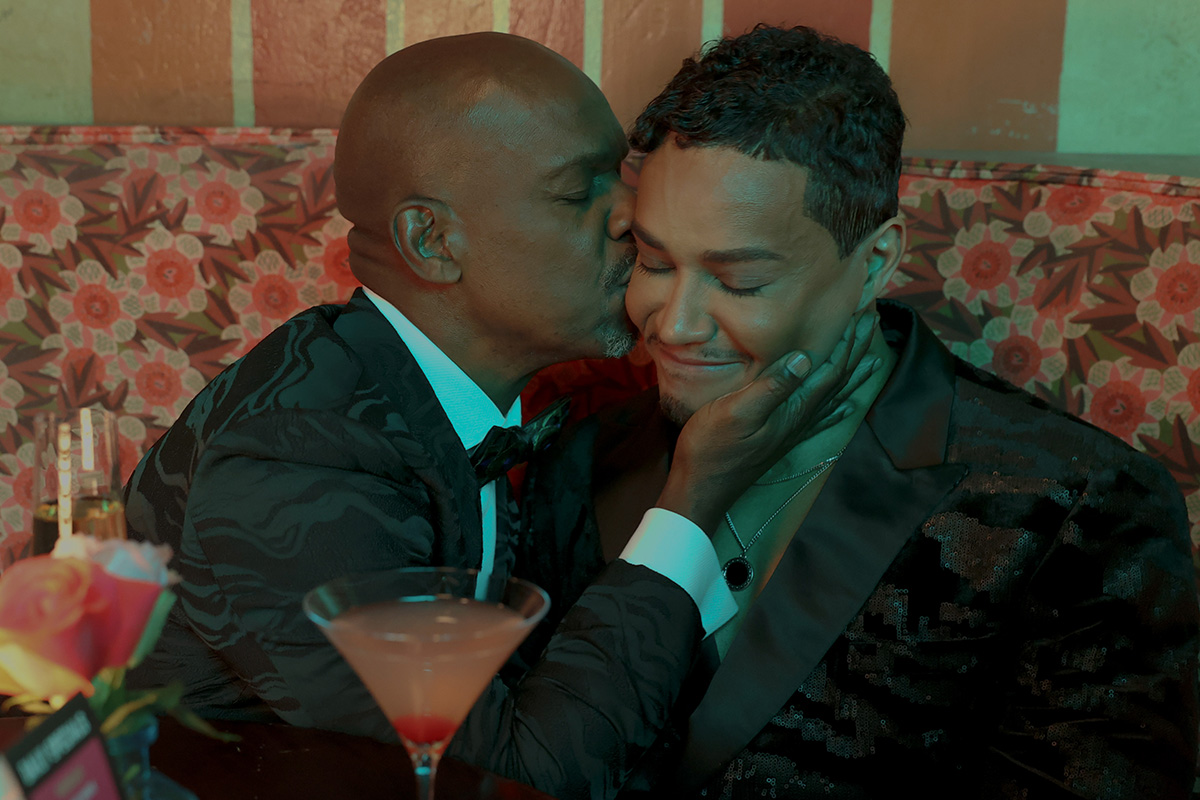
There’s no question that when Patrik-Ian Polk’s series “Noah’s Arc” premiered on Logo 20 years ago, it was a groundbreaking creation. The story of a group of Black gay men and their wonderful friendship. The titular arc was that of the cute main character, Noah (Darryl Stephens), and his close-knit circle of friends, including Chance played by gay actor Doug Spearman. This compelling and loving fraternity may, in fact, be what brought viewers back repeatedly, including a 2008 movie, “Noah’s Arc: Jumping the Broom,” as well as the 2020 “Noah’s Arc” short, and now, a new full-length feature “Noah’s Arc: The Movie,” debuting on Paramount+ on June 20. In the movie, filled with equal measures of laughs and tears, Chance, who has faced a devastating loss, finds his dependable friends there, ready to support and comfort him at a moment’s notice. I had the pleasure of speaking with Spearman the morning of the streaming premiere of “Noah’s Arc: The Movie.”
WASHINGTON BLADE: Doug, since the early 2000s, when the “Noah’s Arc” series premiered on Logo, you have been playing the character of Chance, including in the latest installment, “Noah’s Arc: The Movie.” What was it about Chance that appealed to you as an actor?
SPEARMAN: When Patrik (-Ian Polk) called me to ask me to play him (Chance), I was at JFK airport in the baggage claim, waiting for a suitcase. He explained what the part was. The thing that stuck out to me was the fact that Chance was in a long-term relationship with another Black man. And, they had a child; they had a 4-year-old daughter named Kenya. I had never seen two Black gay men raise a child on TV before. I thought it was the most revolutionary thing I’d ever seen. I immediately thought I’ve got to do this because that was something nobody had seen. I thought it was incredibly important to take the part.
BLADE: “Noah’s Arc: The Movie” was, once again, written and directed by Patrik-Ian Polk, who you just mentioned, is the creator of the entire franchise. What’s the secret to your long-standing working relationship?
SPEARMAN: [Laughs] the whole team, all of us, are like a band of brothers. We fight like brothers, we come together like brothers, we hash things out, we talk, because we’re all very different from our characters. I think the challenge of playing these guys and then uplifting these men, playing a part, especially something written by Patrik, is like solving a math equation. There’s always a challenge that’s enjoyable for me as an actor: to try to find out what it is that Patrik wants, and then how do I do it.
BLADE: I think you do a very good job of it.
SPEARMAN: Thank you very much
BLADE: In the years between “Jumping the Broom” and the new full-length movie, many changes have occurred, and the story addresses some of them, including gay widowhood, which is something that the aging community is now confronting, as well as mental health issues. Please say a few words about how you approached those subjects in the new movie.
SPEARMAN: I had a lot of loss in my life, right before we started shooting. Two months before we started shooting the first series, my mother died. I was going through the grief process through that whole first season. Since then, I’ve lost a lot of people in my life. In fact, when we started shooting the second season, the second week we were shooting, my ex died of a heart attack. I was having to fold that into what I was doing with my life on the set and off the set. You’ve got to show up and you’ve got to do your work. The first two seasons of “Noah’s Arc” are always tinged with the memory of grief. So, when I had to deal with the death that Chance faces (in the new movie), which is a significant death in his life, it wasn’t that hard to reach back, especially the scene in the graveyard. It was something that I unfortunately could pull from personal experience.
BLADE: Shifting gears, the movie features delightful cast surprises, including Jasmine Guy and TS Madison. Did you have a chance to interact with either or both when they were on set?
SPEARMAN: No, I didn’t have any scenes with Jasmine, and I missed her. I wish I had gotten to see her because I actually got to direct Jasmine for a CBS promo shoot for “Queen,” back in the early ‘90s. I had a huge crush on her when she was on “A Different World.” So, I really would have liked to reconnect. But TS and I got to see each other every day because I was in all her scenes. It was extraordinary being around somebody like that. That is one outspoken woman!
BLADE: Even though Beyoncé never makes an appearance in the movie, there’s a lot of talk about her. Would you say you are a Beyoncé fan?
SPEARMAN: Yes! I’m breathing! Yes, I’m a Beyoncé fan. I actually got the chance to meet her. I knew her mom. Her mom was extraordinary to me. She is in the second movie I directed. She also gave us a wedding gown to use in the very first scene of the movie. That family is extraordinarily important to me. Not only just to be a fan, but to be somebody who’s gotten to know them and work with them and see how hard they work. I don’t think anybody works as hard as Tina or Beyoncé.
BLADE: There was a recent news item about gay actor Benito Skinner of the Amazon Prime series “Overcompensating” being told not to bother auditioning for straight roles. As an out actor yourself, how important do you think it is for queer characters to be portrayed by queer actors, and vice versa?
SPEARMAN: Being queer is a multifaceted identity. There’s no one kind of queer person. I think finding the best actor that’s your first circle of casting. I think one of the joys about being an actor is that you get to play different parts. I play straight guys all the time. Dads and husbands and things like that. I think a lot of people are told not to do it. In fact, I wouldn’t be Chance if the actor who was originally cast as Chance hadn’t been pulled out of the series by his agents because they didn’t want him to play a gay character.
BLADE: That’s amazing! Thank you for sharing that. Without giving away too much, the ending of the movie is a little ambiguous, even ending with a question mark. If there was a “Noah’s Arc: The Movie” sequel, would you come back for that?
SPEARMAN: Yeah! A lot of it would depend on what Chance’s journey is going to be like. Patrik and I have conversations like that all the time. He’s very interested and supportive of input. I hope I would be, as we all would be, part of the creative growth with these characters. They live in Patrik’s head, and he writes them, but we’re the ones who have to flesh them out. It’s a conversation, it’s always a conversation.
BLADE: You are currently performing in Molière’s “The Imaginary Invalid” as part of the New Orleans Shakespeare Festival at Tulane. What has this experience been like for you?
SPEARMAN: It’s extraordinary! I started on stage when I was seven. There’s nothing like working with a live audience and having that immediacy. I’m working with an extraordinarily talented cast in a really great play, and I have some of the best scene partners I could ever want.
BLADE: Are there any upcoming film or TV projects you’d like to mention?
SPEARMAN: I’m still a writer, and I’m still a director, and I’ve still got scripts that I would like to make. I have a little something that’s a cross between “Treme” and “Bridgerton” that I want to do. I’m always trying to figure out what the next thing is.
a&e features
Visit Cambridge, a ‘beautiful secret’ on Maryland’s Eastern Shore
New organization promotes town’s welcoming vibe, LGBTQ inclusion
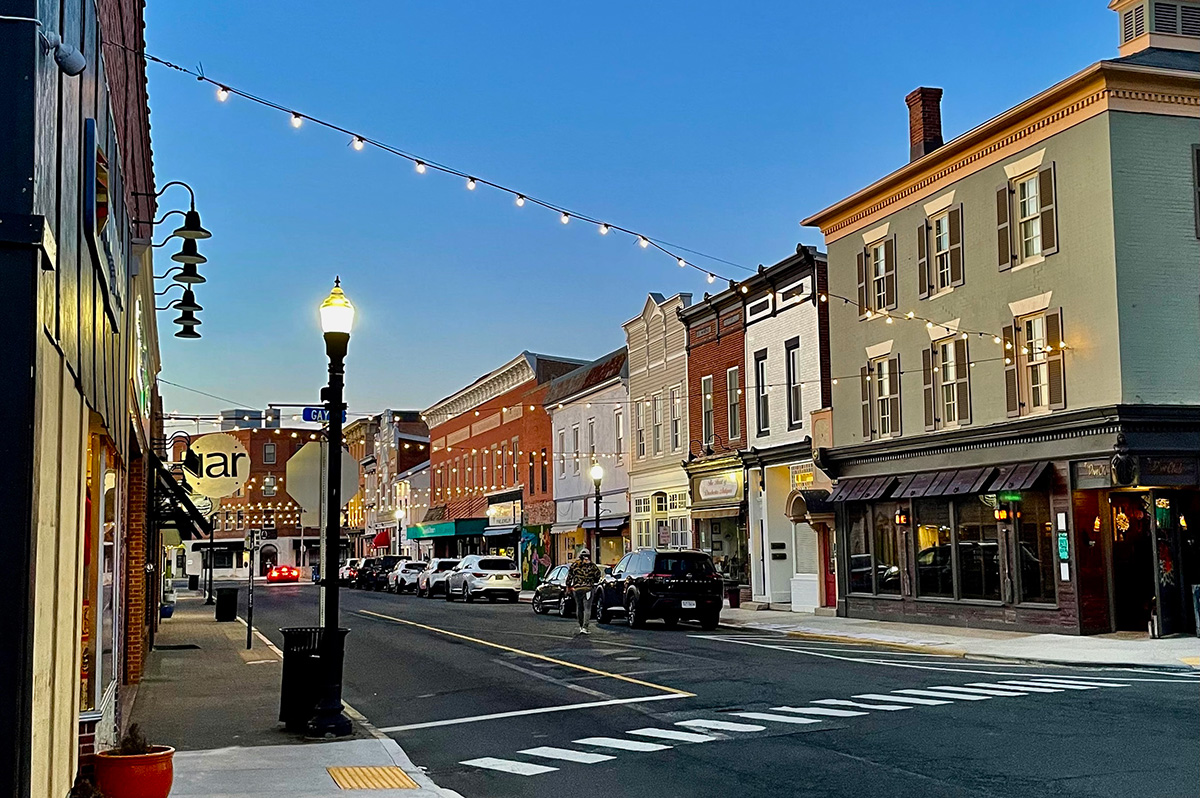
CAMBRIDGE, Md. — Driving through this scenic, historic town on Maryland’s Eastern Shore, you’ll be charmed by streets lined with unique shops, restaurants, and beautifully restored Victorian homes. You’ll also be struck by the number of LGBTQ Pride flags flying throughout the town.
The flags are a reassuring signal that everyone is welcome here, despite the town’s location in ruby red Dorchester County, which voted for Donald Trump over Kamala Harris by a lopsided margin. But don’t let that deter you from visiting. A new organization, Proudly Cambridge, is holding its debut Pride event this weekend, touting the town’s welcoming, inclusive culture.
“We stumbled on a beautiful secret and we wanted to help get the word out,” said James Lumalcuri of the effort to create Proudly Cambridge.
The organization celebrates diversity, enhances public spaces, and seeks to uplift all that Cambridge has to share, according to its mission statement, under the tagline “You Belong Here.”
The group has so far held informal movie nights and a picnic and garden party; the launch party is June 28 at the Cambridge Yacht Club, which will feature a Pride celebration and tea dance. The event’s 75 tickets sold out quickly and proceeds benefit DoCo Pride.
“Tickets went faster than we imagined and we’re bummed we can’t welcome everyone who wanted to come,” Lumalcuri said, adding that organizers plan to make “Cheers on the Choptank” an annual event with added capacity next year.
One of the group’s first projects was to distribute free Pride flags to anyone who requested one and the result is a visually striking display of a large number of flags flying all over town. Up next: Proudly Cambridge plans to roll out a program offering affirming businesses rainbow crab stickers to show their inclusiveness and LGBTQ support. The group also wants to engage with potential visitors and homebuyers.
“We want to spread the word outside of Cambridge — in D.C. and Baltimore — who don’t know about Cambridge,” Lumalcuri said. “We want them to come and know we are a safe haven. You can exist here and feel comfortable and supported by neighbors in a way that we didn’t anticipate when we moved here.”
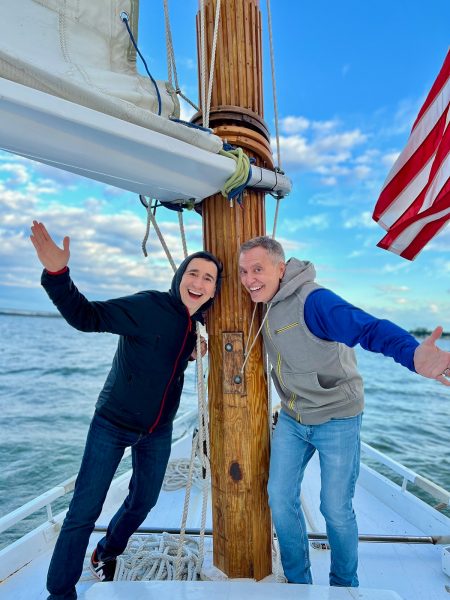
Lumalcuri, 53, a federal government employee, and his husband, Lou Cardenas, 62, a Realtor, purchased a Victorian house in Cambridge in 2021 and embarked on an extensive renovation. The couple also owns a home in Adams Morgan in D.C.
“We saw the opportunity here and wanted to share it with others,” Cardenas said. “There’s lots of housing inventory in the $300-400,000 range … we’re not here to gentrify people out of town because a lot of these homes are just empty and need to be fixed up and we’re happy to be a part of that.”
Lumalcuri was talking with friends one Sunday last year at the gazebo (affectionately known as the “gayzebo” by locals) at the Yacht Club and the idea for Proudly Cambridge was born. The founding board members are Lumalcuri, Corey van Vlymen, Brian Orjuela, Lauren Mross, and Caleb Holland. The group is currently working toward forming a 501(c)3.
“We need visibility and support for those who need it,” Mross said. “We started making lists of what we wanted to do and the five of us ran with it. We started meeting weekly and solidified what we wanted to do.”
Mross, 50, a brand strategist and web designer, moved to Cambridge from Atlanta with her wife three years ago. They knew they wanted to be near the water and farther north and began researching their options when they discovered Cambridge.
“I had not heard of Cambridge but the location seemed perfect,” she said. “I pointed on a map and said this is where we’re going to move.”
The couple packed up, bought a camper trailer and parked it in different campsites but kept coming back to Cambridge.
“I didn’t know how right it was until we moved here,” she said. “It’s the most welcoming place … there’s an energy vortex here – how did so many cool, progressive people end up in one place?”
Corey van Vlymen and his husband live in D.C. and were looking for a second home. They considered Lost River, W.Va., but decided they preferred to be on the water.
“We looked at a map on both sides of the bay and came to Cambridge on a Saturday and bought a house that day,” said van Vlymen, 39, a senior scientist at Booz Allen Hamilton. They’ve owned in Cambridge for two years.
They were drawn to Cambridge due to its location on the water, the affordable housing inventory, and its proximity to D.C.; it’s about an hour and 20 minutes away.
Now, through the work of Proudly Cambridge, they hope to highlight the town’s many attributes to residents and visitors alike.
“Something we all agree on is there’s a perception problem for Cambridge and a lack of awareness,” van Vlymen said. “If you tell someone you’re going to Cambridge, chances are they think, ‘England or Massachusetts?’”
He cited the affordability and the opportunity to save older, historic homes as a big draw for buyers.
“It’s all about celebrating all the things that make Cambridge great,” Mross added. “Our monthly social events are joyful and celebratory.” A recent game night drew about 70 people.
She noted that the goal is not to gentrify the town and push longtime residents out, but to uplift all the people who are already there while welcoming new visitors and future residents.
They also noted that Proudly Cambridge does not seek to supplant existing Pride-focused organizations. Dorchester County Pride organizes countywide Pride events and Delmarva Pride was held in nearby Easton two weeks ago.
“We celebrate all diversity but are gay powered and gay led,” Mross noted.
To learn more about Proudly Cambridge, visit the group on Facebook and Instagram.
What to see and do
Cambridge, located 13 miles up the Choptank River from the Chesapeake Bay, has a population of roughly 15,000. It was settled in 1684 and named for the English university town in 1686. It is home to the Harriet Tubman Museum, mural, and monument. Its proximity to the Blackwater National Wildlife Refuge makes it a popular stop for birders, drawn to more than 27,000 acres of marshland dubbed “the Everglades of the north.”
The refuge is walkable, bikeable, and driveable, making it an accessible attraction for all. There are kayaking and biking tours through Blackwater Adventures (blackwateradventuresmd.com).
Back in town, take a stroll along the water and through historic downtown and admire the architecture. Take in the striking Harriet Tubman mural (424 Race St.). Shop in the many local boutiques, and don’t miss the gay-owned Shorelife Home and Gifts (421 Race St.), filled with stylish coastal décor items.
Stop for breakfast or lunch at Black Water Bakery (429 Race St.), which offers a full compliment of coffee drinks along with a build-your-own mimosa bar and a full menu of creative cocktails.
The Cambridge Yacht Club (1 Mill St.) is always bustling but you need to be a member to get in. Snapper’s on the water is temporarily closed for renovations. RaR Brewing (rarbrewing.com) is popular for craft beers served in an 80-year-old former pool hall and bowling alley. The menu offers burgers, wings, and other bar fare.
For dinner or wine, don’t miss the fantastic Vintage 414 (414 Race St.), which offers lunch, dinner, wine tasting events, specialty foods, and a large selection of wines. The homemade cheddar crackers, inventive flatbreads, and creative desserts (citrus olive oil cake, carrot cake trifle) were a hit on a recent visit.
Also nearby is Ava’s (305 High St.), a regional chain offering outstanding Italian dishes, pizzas, and more.
For something off the beaten path, visit Emily’s Produce (22143 Church Creek Rd.) for its nursery, produce, and prepared meals.
“Ten minutes into the sticks there’s a place called Emily’s Produce, where you can pay $5 and walk through a field and pick sunflowers, blueberries, you can feed the goats … and they have great food,” van Vlymen said.
As for accommodations, there’s the Hyatt Regency Chesapeake Bay (100 Heron Blvd. at Route 50), a resort complex with golf course, spa, and marina. Otherwise, check out Airbnb and VRBO for short-term rentals closer to downtown.
Its proximity to D.C. and Baltimore makes Cambridge an ideal weekend getaway. The large LGBTQ population is welcoming and they are happy to talk up their town and show you around.
“There’s a closeness among the neighbors that I wasn’t feeling in D.C.,” Lumalcuri said. “We look after each other.”
a&e features
James Baldwin bio shows how much of his life is revealed in his work
‘A Love Story’ is first major book on acclaimed author’s life in 30 years

‘Baldwin: A Love Story’
By Nicholas Boggs
c.2025, FSG
$35/704 pages
“Baldwin: A Love Story” is a sympathetic biography, the first major one in 30 years, of acclaimed Black gay writer James Baldwin. Drawing on Baldwin’s fiction, essays, and letters, Nicolas Boggs, a white writer who rediscovered and co-edited a new edition of a long-lost Baldwin book, explores Baldwin’s life and work through focusing on his lovers, mentors, and inspirations.
The book begins with a quick look at Baldwin’s childhood in Harlem, and his difficult relationship with his religious, angry stepfather. Baldwin’s experience with Orilla Miller, a white teacher who encouraged the boy’s writing and took him to plays and movies, even against his father’s wishes, helped shape his life and tempered his feelings toward white people. When Baldwin later joined a church and became a child preacher, though, he felt conflicted between academic success and religious demands, even denouncing Miller at one point. In a fascinating late essay, Baldwin also described his teenage sexual relationship with a mobster, who showed him off in public.
Baldwin’s romantic life was complicated, as he preferred men who were not outwardly gay. Indeed, many would marry women and have children while also involved with Baldwin. Still, they would often remain friends and enabled Baldwin’s work. Lucien Happersberger, who met Baldwin while both were living in Paris, sent him to a Swiss village, where he wrote his first novel, “Go Tell It on the Mountain,” as well as an essay, “Stranger in the Village,” about the oddness of being the first Black person many villagers had ever seen. Baldwin met Turkish actor Engin Cezzar in New York at the Actors’ Studio; Baldwin later spent time in Istanbul with Cezzar and his wife, finishing “Another Country” and directing a controversial play about Turkish prisoners that depicted sexuality and gender.
Baldwin collaborated with French artist Yoran Cazac on a children’s book, which later vanished. Boggs writes of his excitement about coming across this book while a student at Yale and how he later interviewed Cazac and his wife while also republishing the book. Baldwin also had many tumultuous sexual relationships with young men whom he tried to mentor and shape, most of which led to drama and despair.
The book carefully examines Baldwin’s development as a writer. “Go Tell It on the Mountain” draws heavily on his early life, giving subtle signs of the main character John’s sexuality, while “Giovanni’s Room” bravely and openly shows a homosexual relationship, highly controversial at the time. “If Beale Street Could Talk” features a woman as its main character and narrator, the first time Baldwin wrote fully through a woman’s perspective. His essays feel deeply personal, even if they do not reveal everything; Lucian is the unnamed visiting friend in one who the police briefly detained along with Baldwin. He found New York too distracting to write, spending his time there with friends and family or on business. He was close friends with modernist painter Beauford Delaney, also gay, who helped Baldwin see that a Black man could thrive as an artist. Delaney would later move to France, staying near Baldwin’s home.
An epilogue has Boggs writing about encountering Baldwin’s work as one of the few white students in a majority-Black school. It helpfully reminds us that Baldwin connects to all who feel different, no matter their race, sexuality, gender, or class. A well-written, easy-flowing biography, with many excerpts from Baldwin’s writing, it shows how much of his life is revealed in his work. Let’s hope it encourages reading the work, either again or for the first time.
-

 U.S. Supreme Court4 days ago
U.S. Supreme Court4 days agoSupreme Court to consider bans on trans athletes in school sports
-

 Out & About4 days ago
Out & About4 days agoCelebrate the Fourth of July the gay way!
-

 Virginia4 days ago
Virginia4 days agoVa. court allows conversion therapy despite law banning it
-

 Opinions5 days ago
Opinions5 days agoCan we still celebrate Fourth of July this year?

